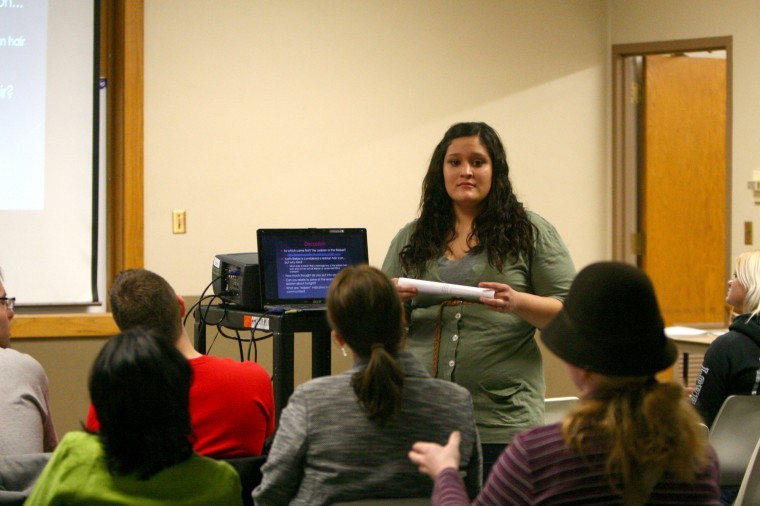The locks that link lesbians and Bieber
Senior women’s studies major Nicole Arteaga presents part of Lesbian? Bieber? Lesbieber?!, a talk given Wednesday night in the Holmes Student Center. The event discussed the socially-concieved correlations between hairstyle and sexual orientation.
April 6, 2011
In Nicole Arteaga’s professional opinion, my haircut is Bieber-esque.
Like a classy bowl-cut, it’s shaggy and swept to the side. Could it be said that I look like a lesbian who looks like Justin Bieber? Confused? You should be.
The Lesbian, Gay, Bisexual, and Transgender Resource Center and the Women’s Resource Center challenged the idea of hair as an indicator of gender identity and sexuality Wednesday night in the Holmes Student Center Heritage Room in the co-sponsored discussion, “Lesbian? Bieber? Lesbieber?!”
Lead by Arteaga, senior women’s studies major and Lettie Morgan, senior political science major, the event was a direct address to the increasingly-popular website LesbiansWhoLookLikeJustinBieber.tumblr.com, where self-proclaimed Lesbiebers or Biebians voluntarily submit photos of themselves sporting a coif akin to that of the teen idol.
“The website, Lesbians Who Look Like Justin Bieber, came across my path couple of different times and because of that it was unavoidable to take notice,” said Molly B. Holmes, Director of Lesbian, Gay, Bisexual, Transgender Resource Center. “That led me to the more intellectual pieces of it. I thought this would be a great way to connect a frivolous pop culture piece to the academic pieces.”
As one would expect, the event had a humorous tone. Opening by playing “Baby,” by Justin Bieber, Arteaga and Morgan kept the audience giggling with a game of “Guess the Gay,” where pictures of women with various hairstyles were presented and audience members tested their often inaccurate “gaydar.”
“There’s really no such thing as gay or straight hair,” said Morgan.
Using some audience misconceptions as a launching point, Arteaga and Morgan explained that, while certain hairstyles have certain masculine or feminine associations, the spectrum is broad. There is no one homosexual style, but hair can be an important aspect of a lesbian’s coming out process in being recognized and fitting in, Arteaga said.
“Hair is largely significant in the lesbian and queer community,” Arteaga said. “There is a lot of literature that examines what role hair plays when a lesbian comes out.”
It can get confusing. While stereotypes are inherently wrong, hair does play a critical role in how individuals of all orientations display their identity. “Lesbian? Bieber? Lesbieber?!” did a great job at presenting this paradox in a humorous light, allowing the audience to participate in a friendly atmosphere.
“The initial title, Lesbian? Bieber? Lesbieber?! is a lighthearted approach,” Holmes said. “I think that because hair is so central to who we are, if we don’t laugh at it, I think we can take it way too seriously sometimes. The humor breaks the ice and allows us to have some of the deeper level discussions that we had here tonight.”







